
Up until 2019, Phyllis Kramer (OBM) developed and maintained this
KahilaLink. Phyllis did a wonderful job documenting and sharing
information about this shtetl. Starting in July 2021 Jeff
Alexander is trying to fill Phyllis shoes. Please contact Jeff
Alexander for anything related to this shtetl
Our wonderful researcher found quite a few references to Dukla.
She extracted interesting notes from many sources. Most touch on
the synagogue, the cemetery, the Jewish Population and the
Holocaust.
- About Dukla: "(3300 inhabitants,. of whom 2600 Jews); a
"Motel" with Lichtmann's Restaurant. In Polish times Dukla was a
rich trading town, in particular the wine trades. The main
Polish-Hungarian trade route went through Dukla. In 1474 the
town was destroyed by the Hungarians during war. In the state of
Galicia it was one of the 20 district "capitals". Today there is
not even a mayor; only many old buildings which show the former
wealth of the town.(...)"
- Eleonora Bergman and Jan Jagielski - Zachowane Synagogi i
Domy Modlitwy w Polsce (Preserved Synagogues and Houses of
Prayer in Poland, published by the Jewish Historical Institute
in Warsaw, 1996 - ISBN 83-8588-23-3):
First mention of and settlement in Dukla in 1380.... Larger
numbers of Jews settled in Dukla the latest in the 18th
Century. ... In 1895 establishment of the gymnasium by the
Baron Hirsch Foundation. It was in permanent state of conflict
with the chassids of Rymanow.
Population of Jews in Dukla
1674 - 23 Jews
1765 - 347 Jews
1881 - 2553 Jews = 84.2% of the population
1900 - 2539 Jews = 79% of the population
1921 - 1509 Jews = 72.5% of the population
In the 18th Century there was a wooden synagogue. It burned
down in 1758. In the same year (and probably in the same
place) a brick synagogue was built in the eastern part of town
(Cergowska Street). The main room had a square floor plan of
12 x 16 meters with the bimah in the center between four
columns. A gallery for women was on the north side. After
1945, the building was used as storage for fuel. Only the
walls of the main room with its ornamental portal on the west
side have been preserved. In 1959 the walls were shored up. In
the interior of the main room on the east side the niche for
the aron ha-kodesh and on the south wall fragments of
inscriptions (prayers) have been preserved.
In 1932, during renovation work in the Tarnowski Palace two
mazzevahs were found: one from the end of the 17th Century and
one from the beginning of the 18th Century.
There are two cemeteries. In the so-called Old Cemetery
approximately 100 gravestones have been preserved, in the New
Cemetery approximately 160. (see cemeteries, below)
- Przemyslaw Burchard - Pamiatki i zabytki kultury zydowskiej w
Polsce (Mementoes and Monuments of Jewish Culture in Poland ,
Warsaw 1990
- S y n a g o g u e, Cergowska Street. Built in 1758; since
1945 dilapidated. Only the walls have been preserved.
- C e m e t e r y, Kosciuszki Street: Year of opening
unknown, size 0.95 hectares, surrounded by an overgrown
whitehorn hedge, ruined, approximately 100 incomplete or
broken gravestones preserved.
- C e m e t e r y, Kosciuszki Street: The so-called New
Cemetery, probably established in the 19th Century, size 4
hectares, ruined, approximately 160 gravestones; monument
for the 40 Jews who were shot by the Nazis. During the war
parts of the gravestones were used by the Nazis to reinforce
the embankments of the stream that provides water to the
firebrigade in Smereczne (today on this site the ruins of a
collective farm).
- J e w i s h S c h o o l: Built at the end of the 19th C.
by the Baron Hirsch Foundation, vernacularly called the
"Jewish Stock Exchange" (bursa zydowska). Today - state
school.
A brief History:
15 km S of the station in Iwonicz, in the mountains, is
situated Dukla (3300 inhabitants of whom 2600 Jews). (...) A
one-horse hackney-carriage from Iwonicz to Dukla costs 3 K., a
two-horse cab 7 K., a seat in the post carriage costs 1.50 K;
they leave Iwonicz at 6 and 7.30 a.m. and at 2.00 p.m. "Motel"
(zajazd) with restaurant of Lichtmann (rooms 1.50-2 K.). also,
a restaurant in Kasyno and the breakfast-room of Henryk Muzyk.
In Polish times Dukla was a rich (particularly wine) trading
town. The main Polish-Hungarian trade route went through
Dukla. In 1474 the town was destroyed by the Hungarians. After
the annexation of Galicia, Dukla belonged to the 20 district
capitals of Galicia. Today, there is not even a mayoralty;
only a large amount of old buildings show the former wealth of
the town.
Highlights: *Palace of the Mecinski (former Mniszech)
family, baroque of the 17th Century. Once it belonged to the
most wealthy and elegant aristocratic residences of Poland. It
is situated in an old park on the stream Jasiolka. It is in a
perfect state. In the palace a significant art collection -
goblets from the King Sigmund era and a rich gallery of
paintings (Rubens, Wouwermann, Claude-Lorrain, Lampe).
*The Parish Church of the 18th Century, renovated in 1907, is
one of the best examples of baroque art in the country. Its
architecture, the frescoes, altar, ambon and benches are all
in the same style. At the side, divided off by beautifully
ornamented wrought iron fences, chapels with cupolas, full of
gold and mirrors. In one of these chapels is the sarcophagus
of Maria Mniszchowa, wife of the founder. In the church the
marble gravestone in Empire style of Franciszek Stadnicki.
*The Saint Bernard Church has an impressive 18th Century
facade and gravestones of the Mniszech and Potocki families.
Dukla is the birthplace of St. John (Jan) of Dukla. His
hermitage with chapel is located 5 km S of Dukla, near the
village Trzciana. (...)
Source: Dr. M. Orlowicz - Ilustrowany przewodnik po Galicyi
(Illustrated Galicia Guide), Lwów 1914, reprint Krosno 1998 -
ISBN 83-87282-44-8, pages 380-382
. . . .
A More Detailed History:
Some people ascribe to the ancient history that Dukla was
founded by Decebal. This 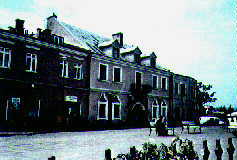 is a fairy
tale. Others claim that Dukla's trade route connected the
Northern Slavs from the Vistula and San with their Southern
brothers from the Danube and Adriatic Sea. Most likely,
however, Dukla owes its beginnings to the times of Casimir the
Great. In a document issued by Casimir the Great in
Wlodzimierz on the 28th of August, 1366, the king approved
chancellor Janusz' inventory of gifts and the division of his
estate in favor of his sons, excluding the female branch. In
this document Dukla is still called a village. Until 1495,
Dukla was the property of the Kobylenski family. In this year
Hieronymus Kobylenski, who had no male descendants, bequeathed
his estate to his brothers Jan and Jakob. (...)
is a fairy
tale. Others claim that Dukla's trade route connected the
Northern Slavs from the Vistula and San with their Southern
brothers from the Danube and Adriatic Sea. Most likely,
however, Dukla owes its beginnings to the times of Casimir the
Great. In a document issued by Casimir the Great in
Wlodzimierz on the 28th of August, 1366, the king approved
chancellor Janusz' inventory of gifts and the division of his
estate in favor of his sons, excluding the female branch. In
this document Dukla is still called a village. Until 1495,
Dukla was the property of the Kobylenski family. In this year
Hieronymus Kobylenski, who had no male descendants, bequeathed
his estate to his brothers Jan and Jakob. (...)
In 1474 the army of the Hungarian King Mathew Korwin
destroyed Dukla. The town was rebuilt and the squire of Dukla
at that time, Stanislaw Szczykowski of Mikluszewice, obtained
in 1504 from King Alexander the Magdeburger Rights.
Szczykowski became the squire of Dukla after the estate was
divided between him and Hieronymus Kobylenski. From
Szczykowski Dukla passed into the hands of Jan Jordan of
Zakliczyn. He obtained from King Sigismund I the privilege for
two fairs (Jahrmarkt) in Dukla. Because Barbara Kobylenska
married Wojciech Mecinski, Dukla became the property of the
Mecinski family. (...) His son, Jan Mecinski, colonel of the
armored division, inherited Dukla. From Jan's mother, the
widow of Andrzej Mecinski, Franciszek Bernard Mniszek,
castellan of Sacz, governor of Sanok, who died in 1661,
obtained a part of Dukla. With tempting promises Rogaczy tried
to get him on his side, but Franciszek who loved his
fatherland stood firm. He married Barbara Stadnicka of
Zmigród. Mniszek who first acquired only a part of Dukla,
later bought the whole town and estate from the Mecinski
family, who left Dukla. The following members of the Mniszek
family owned Dukla: Bernard, his son Jerzy, voivode of Wielun,
governor of Sanok and Szczyrzec, who died in 1693, then
Jerzy's son Józef Lord Chamberlain, governor of Sanok, Jaworów
and Rohatyn, after him Józef's son Jerzy August Wandalin
Mniszek, castellan of Cracow, Sanok, Grudziaz, Krzyczew,
Lubaczów, Ujscie, Pila, court official in the princedom of
Lithuania, later general of Great-Poland (Wielkopolska), a
great defender of privileges and rights at the times of the
Bar Confederation. He founded the Bernardine or Cistercian
convent in Dukla, and he convinced King Stanislas August to
return the former privileges to Dukla, in particular those of
two Jahrmarkts a year and weekly fairs. Beside this, he was
able to obtain the rights for seven Jahrmarkts a year, lasting
seven days. These are: 1) on Monday after the 4th Lent, 2) on
Monday after the Ascension of Christ, 3) after Pentecost, 4)
on John the Baptist's, 5) on St. Michal's, 6) on All Saints'
and 7) on St. Thomas'. This privilege was issued in Warsaw on
December 14, 1766. Jerzy August Mniszek died in Dukla in 1778
at the age of 63. He had two wives: Bihilda Szembekówna who
died in 1747 in Gorszków, and Maria Amalia Fryderyka von
Bruhl, daughter of the first minister of King August III and
Anna Countess of Kollowrath, who died in 1772.
Jerzy August had only a daughter from his second marriage:
Józefa Maria, who married Stanislaw Szczesny Potocki. She died
in 1798 in St. Petersburg at the age of 48. Her husband
obtained Dukla and another estate. When Joseph II of Austria
ordered him to release a Jew from the prison in Krystynopol,
Szczesny Potocki felt deeply upset. The Kaiser forced him to
write in the certificate of discharge: Par super pari non
habet potestatem, ergo iudaeus e carceribus dimittatur (Since
man may not have power over his equal, the Jew must be
released from prison). Humiliated by the verdict, that treated
him and a Jew as an equal, Potocki decided immediately to sell
his estate in Galicia. First he sold Dukla to the governor of
Ostrzeszów, Stadnicki. From the Stadnicki family Dukla passed
again into the hands of the Mecinskis by the marriage of Adam
Mecinski and Aniela Countess Stadnicka. Adam Mecinski,
castellan of Spicimierz, a very wealthy squire, obtained in
1810 the title of Austrian Count. He left behind eight
daughters and three sons of whom the oldest, Count Wojciech,
general and castellan of the Kingdom of Poland, inherited
Dukla. He was married with Helena Countess Stadnicka. His son,
Count Cezary, squire of Dukla, was officer in the Polish army.
He married Gabriela Countess Starzenska (died 1849), daughter
of Count Maciej Starzenski. Their son Adam, born in 1847, is
the current owner of Dukla. In 1876 he married Józefa
Kuczynska, daughter of Alexander major-domo of Podlasy and
Joanna Wulfers.
In the last years before the first division of Poland (1772)
Dukla and vicinity were the scene of skirmishes between the
Confederates and Moskals. On the 14th of May, 1772, the first
Austrian army division crossed the border to Poland. Led by
major of the Hussars, Fabri, who repulsed the Confederates
from Dukla. Three days later Fabri announced General
Esterhazy's manifesto, which was published in German and
Latin. From a document written by an Italian army officer
stating that dissolution and slovenliness rule the townlets of
Galicia, we learn that Tarnów, Zamosc, Dukla and Rzeszów were
laudable exceptions.
In 1849 Russian troops led by General Zydkow and parts of the
Austrian army passed through Dukla; the cavalry was led by
General Schlick, the infantry by General Vogel. In July, 1884,
Dukla was ravaged by fire. 104 Jewish and 6 Catholic houses
burned down. And again in 1891, a great part of the townlet
was destroyed by fire.
Today, Dukla has a new community statute, issued by the Sejm
in November, 1890. As seat of the district government Dukla
has a notary's office, police station, post and telegraph
office. The town has hospital funds, founded by Kazimierz
Michalowski and a local loan bank, with a capital of 2277 zlr.
85 ct. There is a school for boys and girls with five classes.
In the school year of 1892-1893, 519 children attended classes
- 466 of them for daily, and 53 for additional lessons. The
school has eight teachers, a catechist and a teacher for
Jewish religion. It is located in a new one story building,
which was opened in 1879. 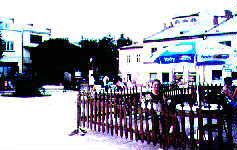 There are
three physicians and one pharmacy in Dukla. The real estate of
Dukla has a value of 27,612 zlr. and 34 cts.(...)
There are
three physicians and one pharmacy in Dukla. The real estate of
Dukla has a value of 27,612 zlr. and 34 cts.(...)
The income of the community amounts to 1,816 zlr. 7 cts. As
in 1891 the needs of the municipality amounted to 5,219 zlr.
38 ct. the difference between the two sums had to be covered
by: (1) local tax of 20%, (2) consumption tax on meat of 50%,
(3) consumption tax on wine of 35%, and (4) levying a charge
on slaughtering in the town's slaughter house. (...)
Dukla has the following factories: an American water-mill, a
brewery, a distillery, three refineries, a stearin and spodium
factory, a soda water factory and a factory producing matches.
Because Dukla is near the Hungarian border, it has been an
important center of the wine trade. This trade, however, lost
its significance by the building of the first
Hungarian-Galician railway. Yet, large amounts of goods
transported by trucks pass Dukla on their way to Hungary and
trucks loaded with Hungarian wine and iron arrive in Galicia.
(...)
Dukla's St. Maria-Magdalena Church was built in 1770.
It houses the magnificent marble gravestone of Amelia von
Bruhl Mniszkowa, wife of Jerzy August Wandalin Mniszek. Beside
this, memorial plates for Teresa Countess Stadnicka
Ossolinska, who died in 1776 and Józef Kante Count Ossolinski,
who died in 1780. The Cistercian convent and St. John's Church
were built between 1739 and 1748. Founder of the convent was
Józef Wandalin Mniszek. His work was completed by his son
Jerzy August. (...) This magnificent aristocratic residence,
which was built in the 17th Century, is hidden in the shade of
hundred year old trees and was renovated by Jerzy Mniszek in
1720. The spacious building has two pavillons with fabulous
works of art and precious historical objects. It has one of
the most significant painting collections of Galicia with
works of Rubens, Albano, Bambocci, Barbus, Wouwermann,
Schalken, Kaisermann, Poussin, Michaud, Claude-Lorrain and
Lampe. (...) (source: #5)
Dukla is the birthplace of St. John of Dukla, in memory of
whom the Cistercian convent was built. In the village of
Trzciana, in the so-called hermitage of St. John, is the
chapel of John of Dukla. On this site stood once an enormous
rock in the shape of a grotto. In this rock cave lived St.
John. He lived on roots and berries and slept on a raffia mat.
When the old chapel burned down in 1879, a new one was built
and consecrated in 1887. It houses the statue of St. John who
worked miracles. (Source: #5)
Statistics. Dukla town - 2.19 square kilometers; 230 houses;
1446 men, 1560 women, together: 3006 inhabitants of whom 520
Catholic, 24 Greek-Orthodox and 2456 Jewish and other
denominations. 2903 inhabitants speak Polish, 5 Russian. Dukla
estate and manor - 2.94 square kilometers; 9 houses, 58 men,
45 women, together 103 people of whom 88 Catholic and 14 other
denominations.(...)
Today Dukla has appr. 2200 inhabitants. The Mecinski-Mniszech
Palace was destroyed during WW II and rebuilt in the 1980s. It
is now named the "Tarnowski Palace" and houses the Historical
Museum of Dukla.
Source: Priest Wladyslaw Sarna - Opis powiatu
krosnienskiego pod wzgledem geograficzno-historycznym
(Geographical-Historical Description of the Krosno
Dictrict), Przemysl 1898, reprint Krosno 1997 - ISBN
83-87282-21-9......pages 458-464
The notes above were translated August, 2000, under the auspices
of the Zmigrod Nowy Research Group.
The Dukla Pass
from an encyclopedia article from Britannica.com.
Polish Przelecz Dukielska, Slovak Prusmyk Dukelskż, passage
through the Carpathian Mountains (locally, the eastern Beskids),
on the frontier between Slovakia and Poland. The Russian army used
the pass to cross Slovakia southward into Hungary in 1849 and used
it again in World Wars I and II. It constitutes a major commercial
route for traffic and goods between Slovakia and Poland.
Return to Table of Contents
. . . .

By our researcher, 8/98.
"A nice little town, less destroyed than Zmigród (or rebuilt?).
With the ruins of the synagoge of 1758, that looks similar to the
ruins of the shul in Rymanow.
The main attractions in Dukla are:
- The church: a well restored and freshly
yellow painted church (18th century) with two huge modern
figures in bronze in front of it, that are discussing next to a
huge wooden cross. I suppose, one of them is St. Jan of Dukla.
- The Historical Museum dedicated to the
battles of Dukla and vicinity, with military vehicles and tanks
in the garden (and a stork nest on the chimney!);
- The market place with the unusual Town Hall
(19th century). It wouldn't surprise me, if the architect had
just returned from the American Wild West, when he was engaged
to draw the blueprint.

What was going on in the market a hundred
years ago, is shown by a postcard that belongs to an interesting
exhibit on the third floor of the musem. Stalls surrounded by
hundreds of people - women with mostly white scarfs and colorful
aprons and large wraps, in front of them on the ground, on carpets
and blankets piles of pots, pans, pails, bowls and baskets, men in
black suits, white shirts and dark hats standing around, examining
the merchandise, bargaining and haggling. It is so noisy, that
they don't hear their own voice. All the stall-keepers, day
laborers, merchants, traders, helping hands, cart-drivers and
carriers we know from the records are gathered on the 250 (?)
square meters of the market place.
The gentlemen from a book-store in Krosno told us that a book
with old postcards and photographs of Dukla is soon to be
published.
Back to the cemetery. It is fenced in, has a
(open) gate, and it was cleaned up a while ago. No bushes, only a
few trees, but knee-high grass and hip-high stinging nettels.
Wearing a solid pair of jeans, socks and running shoes, Deb did
the impossible of indexing the gravestones she could reach and
read. Being not that smart and wearing only a skirt and tennis
shoes, I had to meet a real snake (in Dukla, not in ZMIgród!) that
was sunbathing on an open place between the stones. Because I have
greatest respect for this kind of animals I decided to leave him
alone, and to follow from that moment on only the footsteps of
Deb. Of course I forgot to tell her that the cemetery is full of
vipers and pythons...
The USC is located on the second floor of a
depressing komuna building. Thanks to the Jewish Historical
Institute in Warsaw we were allowed to look through all the vital
records, that are in perfect state. The woman in charge was a
young official, who served us coffee, and her superior was a warm
hearted, energetic woman in her fifties. On the second day we met
the kierownik, a woman in her thirties, tall and neat.
It was a wonderful experience. "
Return to Table of Contents
. . . .
A few years ago the United States Commission reported on the
Cemetery, as follows: The cemetery is south of Dukla, before you 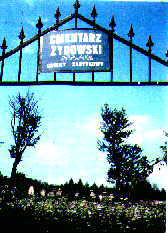 enter village. The cemetery location
is suburban, isolated, and about 20 meters off the road. It is
marked by a sign in Polish, which is used in Poland to mark places
of martyrs, victims, Polish or Jewish, who suffered from the Third
Reich. The cemetery is surrounded by a hedge or row of trees or
bushes around it, with a gate that does not lock. The present size
of cemetery is 20x30m. Approximately, twenty gravestones are in
cemetery. The vegetation overgrowth in the cemetery is a constant
problem which is disturbing graves and disturbing and damaging
stones. Water drainage at the cemetery is like a meadow. The
present owner of the cemetery property is unknown. The cemetery is
known to have been vandalized: stones overturned, broken or stolen
stones, graffiti painted on walls or stones, etc.; graves
desecrated.
enter village. The cemetery location
is suburban, isolated, and about 20 meters off the road. It is
marked by a sign in Polish, which is used in Poland to mark places
of martyrs, victims, Polish or Jewish, who suffered from the Third
Reich. The cemetery is surrounded by a hedge or row of trees or
bushes around it, with a gate that does not lock. The present size
of cemetery is 20x30m. Approximately, twenty gravestones are in
cemetery. The vegetation overgrowth in the cemetery is a constant
problem which is disturbing graves and disturbing and damaging
stones. Water drainage at the cemetery is like a meadow. The
present owner of the cemetery property is unknown. The cemetery is
known to have been vandalized: stones overturned, broken or stolen
stones, graffiti painted on walls or stones, etc.; graves
desecrated.
In 2010 a Polish Cemetery Site summed it up this way: The Jewish
cemetery in Dukla is situated on the southern end of the city, on
the right site of the road towards Barwinek. The necropolis
consists of two parts - the so called old cemetery, established at
the beginning of the XVIII century, and the new cemetery, which,
adjacent to the old one, functions since about 1870. The old
cemetery some of matzevot retained, lots of which are broken and
mossy. The new cemetery, where one can find about 200
well-preserved gravestones, is walled. Unfortunately, many of
matzevot were used by Germans for the regulation of the Smereczna
stream or for building works. The Jewish cemetery in Dukla has a
landmark status. In 2005 the necropolis was tidied up by the
members of the Polish Jewish Students` Union, which, in
cooperation with the Association for the Development of Dukla
Region , aims to gain some funds for the workmanship of the
synagogue`s roof and its fence. (source:
http://www.kirkuty.xip.pl/dukla.htm)
And then, in 1998, Deb Raff went to Dukla. Her notes follow. I
went to Dukla...while researching for our Zmigrod Nowy Research
Group, and had the opportunity to visit the Dukla Cemetery. At the
time I tried to take some notes using my VERY primary level Hebrew
skills. Most gravestones did not seem to have surnames on them. I
actually have photographs of many of the stones!! The Gate was on
the Left and there were 5 rows.
- Row 1...
- SCHEINER?/ SCHNEIER?;
- ? bat Shlomo;
- Itsel? ;
- Chai Ruchel GANTZ?/GAND?
- Bat Meyer Shmuel;
- Basha
- Row 2...
- Blima Bat Moshe the Cohen
- Sara
- Chaya Bat Yitzchak
- Row 3

- Pearl Basha LEHRREICH
- Gittel
- Sarah Pearl bat Naphtali??
- Ester (heh-ayan-nun tet-shin-heh)
- Rasha Gittel bat Yitzchak
- Pina bat Yitzchak
- Ruchel bat Moshe Pesach (heh-nun-resh)
- Row 4
- Michael Jehovah???(yud-heh-vov aleph) bar Uri?? Yakov???
- Joel Michael bar Aron ?(surname- lamed aleph nun nun mem
aleph nun) [crown on this tombstone]
- Moshe KALMAN
- Leiber? Bar David
- Yitzchak Shlomo KAMELHAR(KAMELHAAR) bar
- Mordechai David bar Yitzchak Zev
- Tvi Uri bar Israel Yitzchak
- Naphtali Tvi bar Shmuel
- Row 5
- Yakov? Elias? bar Israel
- Yehuda Dov?
- Yosef Tvi bar Nathan
- Yochanin INDIK/INDYK/INDICH bar Tvi WEIL?
- Yitzchak STEIN bar Moshe Ari? the Cohen
- Rafael MENNER?? bar Yosef
- Efraim bar Yoel ICHEL?
- Abraham bar Moshe Saul
- Ben Zion ? bar Mordechai Dov?
- Ari/Uri?
- Shlomo Zalman ? Moshe
- Shmuel KLEIN? Ben Yosef
- Yosef Chaim bar Moshe Ari/Uri? The Cohen
- Tvi Hirsh bar Yitzchan Menachem-photograph of tombstone
below, courtesty of great granddaughter Orna Muller, Israel,
May 2009
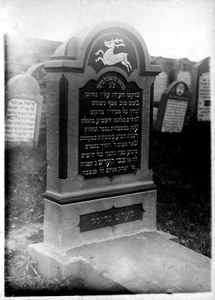
- Tvi Ari/Uri? Bar ?? Ruben
- Zev Ari/Uri?
- Dov bar Israel Yakov
- Berl MEISNER bar Israel Yakov
- Shulem ROTHMAN/N? bar Ari/Uri Zev?
- Yitzchak GETZLER
- David (shin daled/resh lun aleph) bar Israel Tvi
- Yitzchak ?
- Shmuel ben Moshe
- Ari Leibish bar Yosef
For further information, please contact Debbie Raff, Calif.
Return to Table of Contents
. . . .
Taken from Jacek Koszczan's posting on facebook in June 2018:
Work at the old Jewish cemetery in dukla started :) mowing grass
at 30 degrees Celsius, priceless! Tomorrow morning continued :)
thank you Joanna, Barbara and grazynce for help
Isnt that wonderful!!
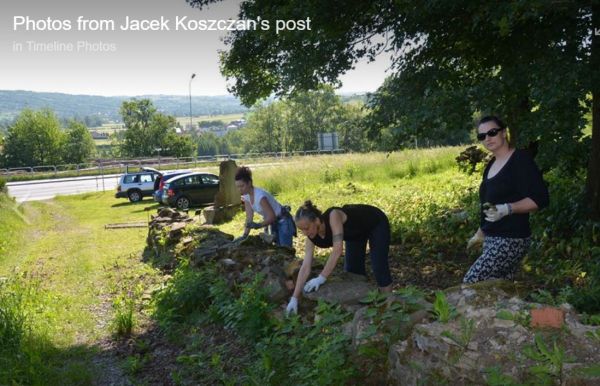
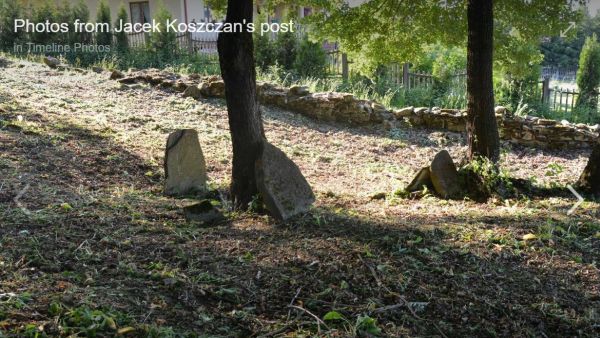
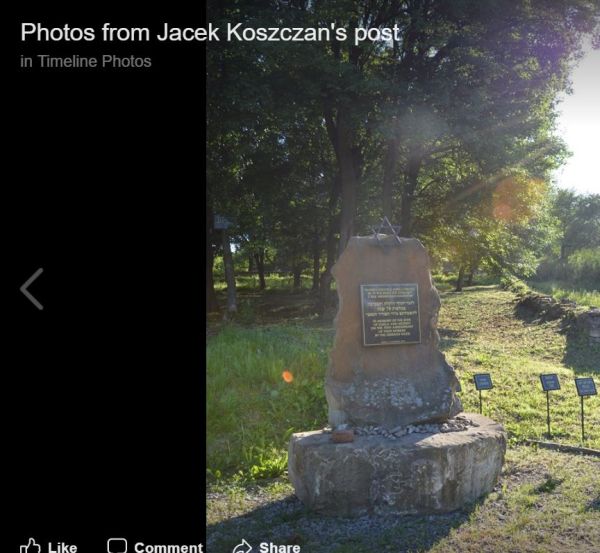
. . . .
Mowing the Old Dukla Cemetery, 2013
Robert sent this message in June of 2013: "Hello. I was mowing
the old cemetary. I was mowing the hand scythe, because the grass
was too high. In the attached are pictures. Best regards"
And he sent these photographs:
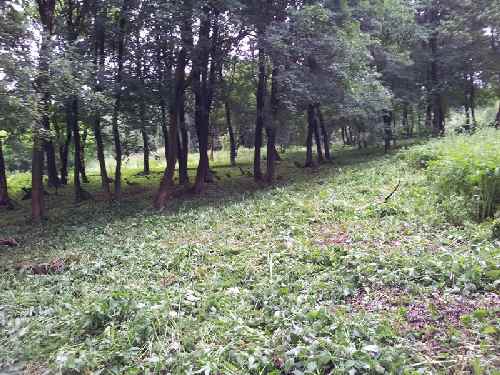
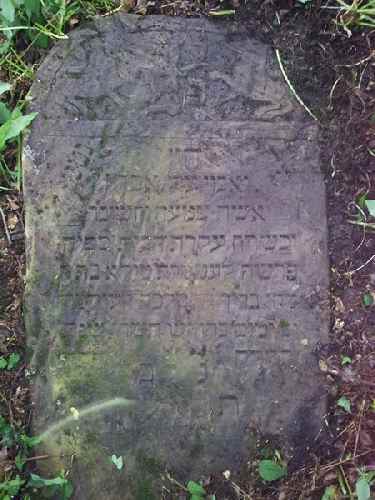
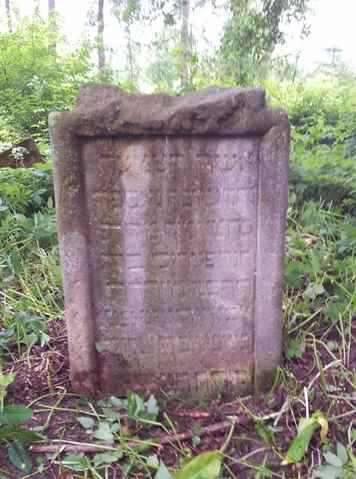
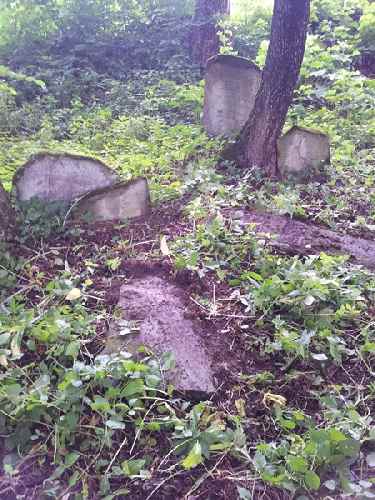

. .
. .
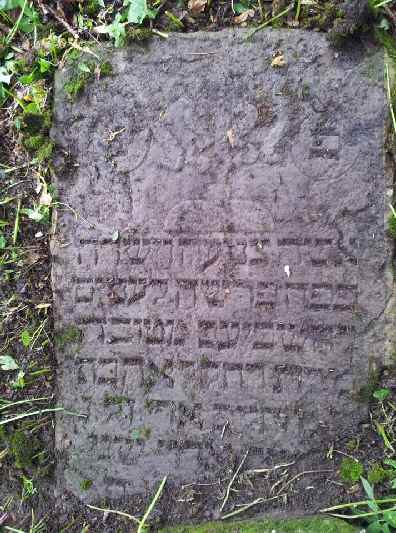


Return to Table of Contents
. .
. .
Thank you again, Robert, for all your wonderful photographs!
. .
. .
Restoration of the Dukla Cemetery, 2013
I received the following message in May of 2013 from Robert
Szczepanik, the Dukla resident who has been sending maps and
photographs to this site for 3 years. He seems to be serious
about upgrading the Jewish memory in Dukla.
My name is Robert Szczepanik. I made contact and
cooperation with the Foundation for the Preservation of Jewish
Heritage (www.fodz.pl), which owns the cemeteries in Dukla. We
want to start renovation, revitalization of the Dukla cemeteries.
They are in a deplorable state.
The work that would be done include:
- Repair wall and gate at the new cemetery. (The cemetery should
be closed because the gravestones are systematically stolen)
- Repairing the wall of an old cemetery.
- Excision of trees, whose roots raise the walls (tip up) and
roll their gravestones.
- Construction of lapidary with other tombstones solved origami
- Recovery of tombstones from the stream in Tylawie and connect
them to a lapidary. (Gravestones the Germans took to the woods
in Tylawie and had put them on pipe length of about 50 meters)
- I would also like to raise the walls of the cemetery chapel
- Fabrication and laying of the foundation board with first and
last names of the Jews who were murdered and buried in a mass
grave near the Dukla.
We need help for specific renovations. Me and Foundation FODZ
(www.fodz.pl - the legal owner of cemeteries) prepare everything.
Currently, we have guidance from conservator. We are looking for
help for the architectural design. It would be a big step to
undertake further work. In addition to the ruins of synagogues,
Jewish cemeteries are the only monument and memorial of the Dukla
Jews before the war was more than is currently Dukla residents. If
we do not save what has been, the memory of the Jews in Dukla will
be lost. And graveyards and cemeteries fall into increasing
disrepair. If you are interesting in helping us, click on my name
to email me.
Thank You Robert Szczepanik,
Tel. 505 696 416
. . . .
by Malka Shacham Doron, Israel August 2009
We've been visiting Dukla cemetry this Sunday, 16th of August
2009 and we found it in a very good condition - cleaned and very
well maintained. It is completely different from last year, when
we were visiting this place - it was neglected, full of bushes and
high grass - please see at the pictures from 2008.
Today, we've met Mr. Mieczyslaw Hinc from Dukla who is taking
care of it voluntarily, without any help from nobody. He was
cutting the grass and bushes at least 4 times from this spring -
as you can see at the pictures from 2009 - every tombstone is
clearly visible and accesible - the cemetery looks just great!
This man should be supported by Dukla municipality and your
organization - he's not taking money but he needs the right
equipment to do this job.
Editor's note: The first few photographs are from 2008, the next
few are from 2009; you can see the wonderful difference in the
cemetery.
2008 Cemetery Photographs
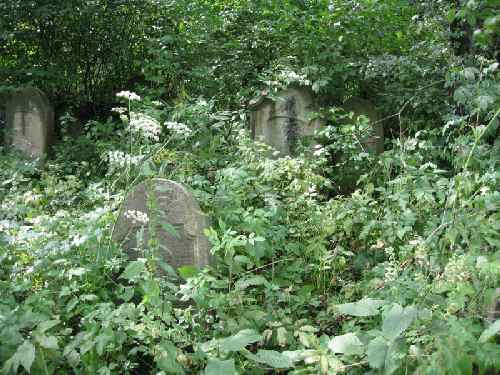
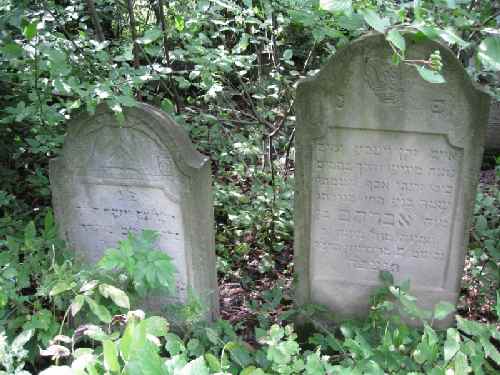
. . . .

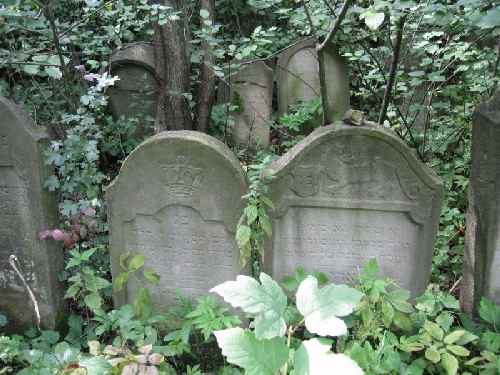
2009 Cemetery Photographs


. . . .
For further information, please contact Malka Shacham Doron, Israel
Return to Table of Contents
. . . .
. . . .
Restoration of the Dukla Cemetery--Dr.
Norman Weinberg april 2004
I received the following message in April 2004, from Dr.Norman
Weinberg: I have received a message from Rabbi Michael
Schudrich, Rabbi of Warsaw and Lodz, regarding Dukla. The
municipality of Dukla has generously offered to pay 40% of the
cost of restoration of the Jewish cemetery of Dukla. This is an
unprecedented opportunity! The total cost of the project is
estimated at 100 000 zl (about 25 000 USD). In addition, we need
to recover the Dukla cemetery matzevot from the river in Jasliska
where they were dumped during the Holocaust. The matzevot would be
photographed, documented and be incorporated in the restored walls
of the cemetery. The resulting documentation would be available to
everyone at no charge, posted on JewishGen.
Why should you be interested in restoring the cemetery and
recovering the matzevot? For many reasons, including: the
cemetery is sacred ground where ancestors are buried, including
for some, parents, grandparents, uncles, aunts and cousins;
cemetery care and restoration is among the greatest mitzvot one
can do; and, the recovered matzevot are a valuable genealogical
resource.
What is needed to get this project underway? Your support
in getting this news to family and other descendants of Dukla. And
someone to volunteer to be the Dukla PJCRP Coordinator to be the
intermediary between the The Poland Jewish Cemetery Restoration
Project (PJCRP) and Dukla descendants.
What is The Poland Jewish Cemetery Restoration Project? The
PJCRP's mission is to restore all 1200 of the devastated Jewish
cemeteries of Poland. See www.pjcrp.org, and as an example, the
website of a PJCRP successfully restored cemetery at
www.ozarow.org. The PJCRP is supported by the US and Polish
Governments and by many Jewish Foundations and organizations.
Rabbi Michael Schudrich is Halachic Coordinator of the PJCRP.
Please participate in this important project
Dr. Norman L. Weinberg, PJCRP Executive Coordinator,
Tel. 716-688-5272. Click here to email Norman Weinberg
Return to Table of Contents
. .
. .
. .
. .
Upon the Doorposts of Thy House,
Jewish Life in East-Central Europe, Yesterday and Today,
the 1994 book by Ruth Ellen Gruber, provides some insight into
what this area was and is like. As part of her most recent
travels, Gruber drove from Hungary to Poland through the Dukla
Pass toward Rymanow, " the town in southern Poland whose Jews had
been so active in the importation of Hungarian wine, and whose
Hassidic masters, among the most famous in Eastern Europe, have
had such devoted followers in the wine villages near Tokaj."
" The Dukla Pass is the lowest and easiest north-south route
through the western Carpathians, and by the sixteenth century it
was already a well-established artery for trade, including the
wine trade. The town of Dukla itself prospered as a major center
for the import of Hungarian wine...
During World War II the Dukla Pass was the scene of bitterly
fought battles between combined Czechoslovak and Soviet armies
and the Germans. The bloody mountain fighting in the autumn of
1944 destroyed German defenses and left a hundred thousand
soldiers dead. The towns of Dukla, to the north of the pass, and
Svidnik in Slovakia, to the south, were almost totally razed. I
passed numerous memorials to this fighting as I drove along the
gentle curves through the wooded hills. Monuments had been
erected to the fallen, and ruined tanks, artillery pieces and
airplanes had been left in place where they had been at the
close of the conflict, rusting memorials to the battle.
Dukla itself was a small town clustered around a stage-set
market square with a white market hall at its center. Nearby, I
found the synagogue. It had been built around the middle of the
eighteenth century...Now it was a ruin. It had been destroyed
during the wartime battles and had simply been left as it was,
four massive stone walls and little else, looming in a small
hollow. At the edge of town, a few graves still stood in the
Jewish cemetery, surrounded by a brilliant carpet of wild spring
flowers."
Return
to Table of Contents
. . . .
Possible Grave of the Dukla Tzadik
Robert S, our friend from Dukla, just finished cutting the grass
in the cemetery...and sent me an email which said: "Recently I
spoke with the oldest living Jew from Dukla, Herman Altholz. He
told me that these ruins next to the Jewish cemetery, it is not
the mortuary chapel. These are the ruins of the Ohel Tzadik.
Probably the tzaddik Horovitz., But this is not certain. Could you
at your website placed the question. Maybe someone knows something
and I need all the information. I will be very grateful. 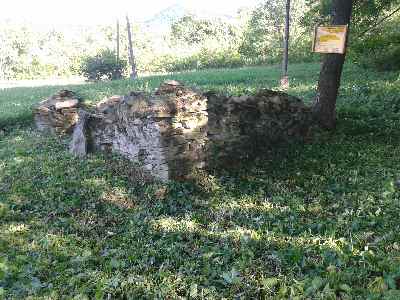
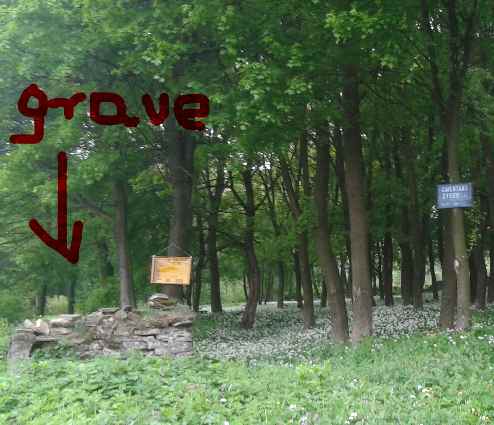
And the latest photograph of the old cemetery...again, from
Robert, May 2013: 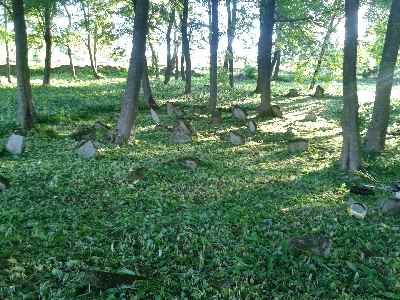
. .
. .
The following was abstracted from
Chester G. Cohen's "Shtetl Finder", Heritage Books, Inc., 1989)
- A rabbi who lived in Dukla was Yiztchak Izik Segal Weisman,
who died in 1888.
- Advance subscribers for the book "Amidehu Sheva":
- Ari'Leibush H'sh (Halberstam), the rabbi,
- Chaim Michal Brost
- Yonah Einger,
- Alter Yosef Feniger
- Yosef Asher Horvitz
- Yechiel Natan H'sh
- Chaim Michal Hertzig,
- Yechiel Michael Henig
- Yeshi' & Moshe Shub Katz
- Kalman Kintzler
- Moshe Daniel Landau
- Yehoshua Parnas
- Yakov Rabin
- Moshe & Yitzak Reich
- Yosef Saltz
- Yekutiel Zalman Shor
- Eleazar Tak
- Dov Yitzchak Veietchner
- Pinchas Veil
- Yechezkel & Naftali Veinberger,
- Simcha Yethi.
- Dukla was the birthplace of Joseph Samuel Bloch 1850-1923,
who was a rabbi and a representative in the Austrian
parliament.
Return
to Table of Contents
. . . .
Rumors spread throughout the hamlet that it too is marked for
elimination. Jewish communities in the area were disappearing at
an alarming rate. Nobody knew what happened but the fact remained
that they were gone. No trace left of entire communities. Of
course, people were killed and massacred but what happened to
entire communities. These thoughts remained with every Jew but
there was no answer. Everybody hoped that perhaps this hamlet
would be the exception. Of course, the Germans always gave
assurances that no changes are in sight. Then things began to move
in a rapid succession.
On Sunday the 5th of August 1942 (26th day of the month of Ab,
Tashab), Von Rauschwitz, (Gestapo commander of the Jaslo district
to which Dukla belonged) with two other henchmen arrived in Dukla.
They went directly to the Judenrat and demanded that it prepare 40
pair of boots until Monday evening. Shimon Shtoff, the head of
the Judenrat collapsed upon hearing the demand. Still the
Judenrat sat for hours and debated the ultimatum or rather how to
fulfill it. By evening, the council agreed on a resolution,
namely, every Jew will pay a tax of 10 zlotys. This will establish
a fund of 35,000 zlotys that will suffice for 35 pair of boots. It
was estimated that a fine pair of boots cost about 1,000 zlotys.
To cover the shortage, the council imposed a tax of 100,000 zlotys
on wealthy Jews of Dukla. Mr. Mordechai Tzehngut immediately
gave 20,000 zlotys and Mordechai Postrung ( married to Sima
Leibner of Zmigrod ) gave 10,000 zlotys.
The council also decided to send a delegation of three members of
the Judenrat with 100,000 zlotys to a Mr. Margolies in Gorlice.
Supposedly, the latter who lived in Germany for many years
was a close friend of Von Rauschwitz. The thought was that he
could influence the German to cancel the extermination that was
scheduled for Dukla. The Judenrat already knew that the Jewish
communities of Zmigrod, Fristik, and others had already been
removed. The dayan (Jewish religious judge) Yeshajahu Schapiro
of Dukla received a letter from his father in law, the
Rabbi of Strzyzow. The letter was written on the road and stated
that the entire Jewish community of Strzyzow is being sent to an
unknown destination. He ends the short note with the famous
historical invocation: "May God have mercy on us".
The delegation with the 100,000 left for Gorlice on Monday
morning, the 5th of August 1942. Later in the day, a police
limousine pulled up in front of the shop of Yehoshua Guzik, the
famous tailor. He used his connections to help Jews whenever
he could. From the car emerged, Mentz, the assistant of the
Gestapo in Jaslo, Paul, the head of the Judenrat division in Jaslo
and two more henchmen. Mentz ordered two suits and insisted that
they be ready within a week. The entire community received the
news of the visit and believed that nothing will happen during the
week The general feeling however was very depressive. Even
optimists like the watchmaker Leib Altholtz began to
change their view. In the evening, the delegation returned from
Gorlice and reported that Margolies stated that nothing will
happen to Dukla according to Von Rauschwitz. At the same time,
reports filtered into Dukla that the city of Krosno is surrounded
with Ukrainian police forces in full battle gear.
The people liked to believe the report of the Judenrat committee
from Gorlice and dismissed the news about Krosno. Then, about 2
P.M.on Tuesday 6th 1942 the Dukla committee that carried food to
the Jewish workers at the nearby quarry returned to the shtetl.
They stated that large pits are being dug in the forest near the
village of Tilawa that is located about 10 kilometers from the
hamlet of Dukla. The committee, headed by Itsche Borenstein,
delivered daily food shipments to the Jewish workers in the quarry
since the Germans hardly fed them in spite of the heavy work. Itsche
Borenstein was also the party that initiated a kitchen
that provided food to the resettled Jews in Dukla. These Jews were
deprived of everything and needed all the help that they could
get. Later, a local JSS (Jewish Self-Help) was established to
provide meals to the needy. The committee was headed by Itsche
Borenstein and received help from the Judenrat and the JSS office
in Krakow.
The oppressive atmosphere of Wednesday, August 7th, 1942 affected
everybody. This was the eve of the new month of Elul. People went
to the cemetery and invoked their parents' intercession on their
behalf. Even children came to pray at the cemetery. Candles were
lit in many places. The shuls and the shtibelech were full of
people praying for the cancellation of the order that was about to
descend on the community. Later that day, Mentz arrived at Guzik's
place and insisted that the suits be finished today. He assured
everybody that nothing would happen in Dukla.
Thursday, August 8th 1942, the first day of the month of Elul
found the Jewish community in a hopeless state. The shtetl was
surrounded with Ukrainian police forces. At 7 A.M the Judenrat
announced throughout the city that all the Jews are to assemble at
the Graf's garden by 9 A.M.. Anyone hiding will be shot on the
spot. Many Jews had the feeling that this was their last journey
and took with them the bare essentials, notably the talith and
phylacteries. The women assembled hastily some items notably
clothing and some food. Thus started the Jewish community to move
to the assembly point. Old, sick, children, parents and entire
families headed in silence to the garden. Inside the garden, there
was a table, next to it stood Von Rauschwitz, Schmatzler (head of
the Gestapo in Krosno), the head of the Ukrainian forces, Shreter,
and a few other henchmen that nobody could identify.
Precisly at 9 A.M. Rauschwitz gave the order of total silence. He
then called the head of the Judenrat, Shimon Shtoff and
gave him instructions. The latter stood up on a chair and
announced that all workers of the quarry of Emil Ludwig-Breslau
and Arthur Walde- Munich, of the Gutes Management, of the sawmill
and of the various German enterprises and offices are to move to
one side with their wives and children. Those Jews that do not
work to move to another section. Children up to the age of 15
years to move to another section. All sick, elderly and disabled
Jews were ordered to another section. Suddenly, a police car
arrived at the scene, an SS man named Dr, Haze stepped out of the
car and ordered Rauschitz to his side. They spoke for a few
minutes and Dr. Haze re-entered the car. A Gestapo man then
grabbed Shimon Shtoff by the collar and booted him into the car
that soon left the area. The Jewish population was terrified.
Meanwhile the Ukrainian police searched the area for hidden Jews
and shot those that they found. The Jewish police was also busy
searching for hidden Jews. They checked the cellars, attics and
hiding places and located an old couple that was led to the
assembly center. The head of the Jewish police presented the
culprits whereupon the Gestapo chief slapped him across the face
and blood started to stream from it. The car returned to the
assembly area and Shimon Shtoff was tossed out of it and fell to
the ground. The car left the area and a Gestapo man read the
following order. All men between 15-35 are to line up along the
wall and face it. All men above 35, all women and children under
15 years of age are to line up in another group. Sick and disabled
people to assemble in another group. Nobody spoke, people were
terrified and said their good-byes by merely blinking their eyes.
A detail of Jews was taken to help load the sick and disabled
onto trucks. Soon the convoy of trucks left for the forest of
Tilawa where they were shot and buried. About 300 Jews from Dukla
and about 200 Jews from Rymanow found their resting place in the
prepared pits of the forest. Amongst those shot were also the
former commander of the Jewish police, Yehezkel Goldman and a
member of the Judenrat, Mordechai Tobias and his wife the
secretary of the Judenrat. The men above 35 years of age, the
women and children were pushed aboard trucks and transported to
the railway station in Iwonicz where they were loaded aboard a
transport for the death camp of Belzec. Amongst the last to be
tossed onto a truck was Shimon Shtoff. The group of men that faced
the wall was then lined up three abreast and marched to two
buildings. There were about 350 men that were divided into two
groups, each group received a building.
Thus on Thursday, August 8th 1942, (the first day of the month
of Elul, Tashab) ended the existence of an old established
Jewish community, namely the kehilla of Dukla. May it be
memorialized for eternity.
Return to Table of Contents
. . . .
The following is an incomplete list of Jews of Dukla, Galicia,
that were killed during the Shoa. The names were found in the
testimonials, witness documents of survivors, witness pages at Yad
Vashem and Beth Hatfutzot. Many of the names were provided by
Dukla survivors or their relatives.
( In Jerusalem, the HALL OF NAMES gathers information on
Holocaust victims and preserves their memory, with recorded PAGES
OF TESTIMONY. These pages are a paper tombstone, with names and
biographical details of Jews who perished. The pages include the
name and address of the submitter.)
- Altholz--Gita, Herman, Leah, Leib, Miriam, Reisel, Tzipe,
Yahet
- Bahrt-- Gisela, Perl
- Bard-- Avraham, Perl, Tzwi
- Beer--Fredal, Jakob, Moishe, Mordechai, Rachel, Rivka, Aaron,
Hersh, Itzhak, Joel, Malka, Rachel
- Beil--Chemje, Frmet, Mayer, Moshe, Nathan, Szifra, Yacov
- Ber, Roza
- Berglas--Blima, Mosche, Reizel
- Bergman--Ester, Gershom, Hersh, Jerachmiel, Luba, Regina,
Shimon
- Bernstein--Itzhak, Sara
- Bindiger, Shmuel
- Birnbaum--Anna, Labe, Rebeca
- Blasberg, Bluma
- Blazbald--Necha, Israel
- Blazvald, Israel
- Bloom, Freda
- Bobker--Chaja, Markus, Rozia
- Boil, Mates
- Brandes--Ides, Rivka
- Brandwein--Kiwe, Marjem
- Braun--Ita, Leon, Taube, Wolf
- Buchfuhrer, Rebeka
- Cajngold--Basia, Pesil
- Cajngold, Zirel
- Cengit--Frimet, Szlomo, Miriam
- Cukerman--Arie, Bela
- Cukerman, Wolf
- Dorf-- Chaja, Liba
- Drutter, Samuel
- Ehrenreich--Dawid, Lea, Mina, Wolf
- Ehrlich--Lea
- Ehrlich, Riwka
- Epsztajn, Gitel
- Faher--Mordechai, Mordechai, Pinhas, Pinhas, Tauber, Tauber
- Fass--Yehudith, Ida, Itzhak, Lea, Nechame, Sheindel, Yossef
- Feuereisen--Basia, Regina
- Fischbein-Itzhak
- Fiszler, Mala
- Flahta--Jehezkel, Mendel, Pesu, Seindel, Yosil
- Fogel, Malka
- Freund, Samuel
- Fridman, Dawid
- Fris--Chana, Mendel
- From--Chawa, Jechiel
- Fuhrer--Bernhard, Czewi, Moses, Moses, Sara
- Furst--Lea, Tolba
- Getreider--Asher, Chaim, Sarah, Shewach
- Getzler--Frimet, Josef, Yehuda
- Glick, Frida
- Goldbaum
- Goldberg, Matel
- Goldbojm, Szmul
- Goldman--Jecheskel, Taube
- Gottfird Naphtali
- Grinfeld--Arie, Lipe
- Grinfeld, Tova
- Grinszpan--Luba, Rafael
- Grinwald, Chaya
- Gruenfeld--Jakob, Mordechai, Rosa
- Grynszpan-Chanha, Liba, Meir, Naftali
- Gutarz, Perl
- Guter, Avigdor
- Gutwirt--Aron, Blima, Dawid, Itzhak, Josef, Rikel
- Guzik--Etel, Malka, Malka, Samuel
- Habenstreit--Lea, Malka
- Haendler, Josef
- Haftel, Ben Tzion
- Halbersztam
- Handler--Asher, Bruno, Feige, Josef
- Heller--Dawid, Sheindel
- Hirschprung--Chaim, Chaja, Lea, Matya
- Hochheizer, Nechame
- Hochstim--Chana, Haim, Samuel
- Hoebenstreit, Isaak
- Horowitz--Dworah, Feige, Lea, Mendel, Reisel
- Indyk-Eliezer, Rivka
- Jafa, Rebeka
- Jakubowitz--Michel, Sara, Shia, Shia
- Jam, Berl
- Kanarek, Hela
- Kanner, Chana
- Klapholz, Matel
- Krill--Ester, Itzhak
- Kuflik, Israel
- Kurzman, Avraham
- Kushenbaum, Tzila
- Levenshtein--Frida, Henia, Israel, Itzhak, Rikel
- Mendel--Herzl, Roze, Wolf, Yehoshua, Yosef
- Moses, Asher
- Nussbaum, Sara
- Pinsker--Naphtali, Pinhas
- Plachta--Chana, Mendel, Pesel, Yehuda--Bluma, Chana, Idil,
Mendil, Pesil
- Plachtner--Mosze
- Plachtner, Sheindel
- Poper, Roza
- Posterung--Mordechai, Sima
- Propker, Mendel
- Puretz, Czewa
- Raab--Ben Tzion, Tila
- Ressler--Chaim, Hersh, Sanyl
- Restler--Chana, Cyla, Gitel, Herman, Mosze, Sara
- Rieder, Israel
- Riter--Pesel, Pinkas
- Rob, Dawid
- Rosenthal--Chaskel, Gisela, Israel, Liba, Luser, Moses,
Rechel, Regina
- Rothman--Brandel, Dov, Elimelech, Kreina, Kreine
- Rozencweig, Mirjam
- Rozner, Chajcia
- Rubenfeld--Eisig, Eisik
- Schein, Frida
- Scherer, Tonka
- Schneebaum, Isaak
- Schuman-Chuna, Lifsia
- Seeman, Dawid
- Segner--Chaja, Chawa, Dawid, Dina, Ester, Mechel, Zalmen
- Seinwel, Samuel
- Sekler, Dobzy
- Sherts, Frida
- Shternberg--Chaim, Chaim, Tzwi
- Siser, Mosze
- Sofsz, Yuda
- Stein --Feitel, Adela, Joseph, Naphtal, Naphtali, Rifka, Tyla
- Steiner--Aron, Dawid, Itzhak, Izak, Malka, Moses, Pinkas,
Rachel, Taube
- Sternberg--Chaim, Regina
- Stoff Pinhas
- Stop, Mala
- Szapira--Malka, Yosef, Ysrael
- Szapiro Jacob, Reisil, Sara, Reisel
- Szerer--Dwora, Leon, Menasze
- Szofsz, Yehuda
- Szpira, Jacob
- Szubin--Frida, Kreindl
- Szwarc, Ester
- Tabisel, Chaja
- Tabizel, Pepa
- Tag, Luzer
- Teitelbaum, Bat Sheva
- Tobias, Shalom
- Unger--Elimelech, Marila, Sara, Serl
- Wakschal, Yehudit
- Walisch, Shmuel
- Weinberger, Haja
- Weinstein--Fradel, Leibisch, Leibish, Pinhas, Sabina
- Weiser, Itzhak
- Weitz, Leib
- Wicerner, Leb
- Wietschner, Samuel
- Willner, Yeshayahu
- Wisniewski, Ruchel
- Wisniowic-Cirl, Jozef, Taube
- Wolf--Eisig, Mina, Mina, Nathan, Rachel
- Yam--Gitel, Mindel
- Zaferman--Lio, Yehoshua
- Zajman, Dawid
- Zalc-Feige, Perl, Dawid
- Zeingold, Schlomo
- Zisswein, Israel
- Zukerman--Chaim, Chawa, Leib, Yehudit
William Leibner, October 3rd 2000. Jerusalem, Israel
Return to Table of Contents
Copyright © (2022) Jeffrey Alexander. All rights reserved.
 is a fairy
tale. Others claim that Dukla's trade route connected the
Northern Slavs from the Vistula and San with their Southern
brothers from the Danube and Adriatic Sea. Most likely,
however, Dukla owes its beginnings to the times of Casimir the
Great. In a document issued by Casimir the Great in
Wlodzimierz on the 28th of August, 1366, the king approved
chancellor Janusz' inventory of gifts and the division of his
estate in favor of his sons, excluding the female branch. In
this document Dukla is still called a village. Until 1495,
Dukla was the property of the Kobylenski family. In this year
Hieronymus Kobylenski, who had no male descendants, bequeathed
his estate to his brothers Jan and Jakob. (...)
is a fairy
tale. Others claim that Dukla's trade route connected the
Northern Slavs from the Vistula and San with their Southern
brothers from the Danube and Adriatic Sea. Most likely,
however, Dukla owes its beginnings to the times of Casimir the
Great. In a document issued by Casimir the Great in
Wlodzimierz on the 28th of August, 1366, the king approved
chancellor Janusz' inventory of gifts and the division of his
estate in favor of his sons, excluding the female branch. In
this document Dukla is still called a village. Until 1495,
Dukla was the property of the Kobylenski family. In this year
Hieronymus Kobylenski, who had no male descendants, bequeathed
his estate to his brothers Jan and Jakob. (...)  There are
three physicians and one pharmacy in Dukla. The real estate of
Dukla has a value of 27,612 zlr. and 34 cts.(...)
There are
three physicians and one pharmacy in Dukla. The real estate of
Dukla has a value of 27,612 zlr. and 34 cts.(...) 
 enter village. The cemetery location
is suburban, isolated, and about 20 meters off the road. It is
marked by a sign in Polish, which is used in Poland to mark places
of martyrs, victims, Polish or Jewish, who suffered from the Third
Reich. The cemetery is surrounded by a hedge or row of trees or
bushes around it, with a gate that does not lock. The present size
of cemetery is 20x30m. Approximately, twenty gravestones are in
cemetery. The vegetation overgrowth in the cemetery is a constant
problem which is disturbing graves and disturbing and damaging
stones. Water drainage at the cemetery is like a meadow. The
present owner of the cemetery property is unknown. The cemetery is
known to have been vandalized: stones overturned, broken or stolen
stones, graffiti painted on walls or stones, etc.; graves
desecrated.
enter village. The cemetery location
is suburban, isolated, and about 20 meters off the road. It is
marked by a sign in Polish, which is used in Poland to mark places
of martyrs, victims, Polish or Jewish, who suffered from the Third
Reich. The cemetery is surrounded by a hedge or row of trees or
bushes around it, with a gate that does not lock. The present size
of cemetery is 20x30m. Approximately, twenty gravestones are in
cemetery. The vegetation overgrowth in the cemetery is a constant
problem which is disturbing graves and disturbing and damaging
stones. Water drainage at the cemetery is like a meadow. The
present owner of the cemetery property is unknown. The cemetery is
known to have been vandalized: stones overturned, broken or stolen
stones, graffiti painted on walls or stones, etc.; graves
desecrated. 




















